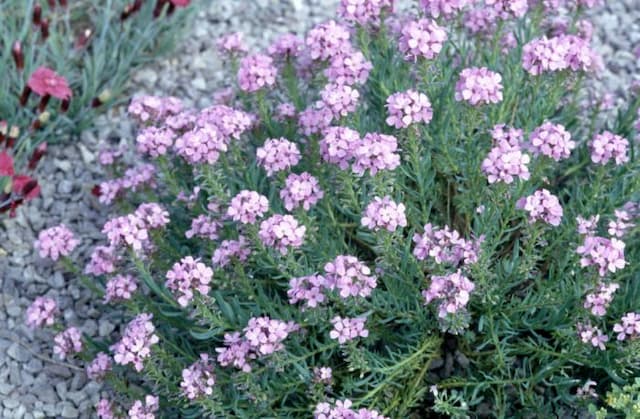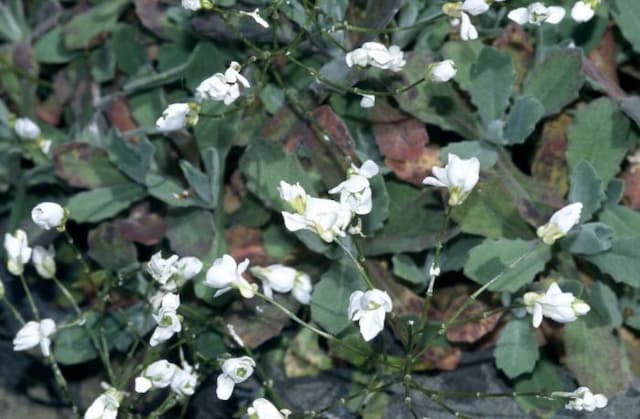Coast Rock Cress Arabis blepharophylla 'Frühlingszauber'

ABOUT
Arabis blepharophylla 'Frühlingszauber', commonly known as Coast Rock Cress, features a low-growing, clumping form with deep green, small, spoon-shaped leaves that are slightly serrated at the edges. Throughout the blooming season, it boasts abundant clusters of vibrant, pink to rose-red flowers with four delicate petals that form a cross shape, which is typical of the family to which it belongs. These blossoms have a noticeable, sweet fragrance that can attract pollinators like bees and butterflies to the garden. The plant is evergreen, providing year-round interest with its foliage, and it turns the area where it thrives into a carpet of color when in full bloom.
About this plant
 Names
NamesFamily
Brassicaceae
Synonyms
Coast Rock Cress, Rose Rock Cress, Spring Charm
Common names
Arabis blepharophylla Hook. & Arn., Arabis blepharophylla var. frondosa Jeps.
 Toxicity
ToxicityTo humans
Coast Rock Cress (Arabis blepharophylla 'Frühlingszauber') is generally not known to be toxic to humans. There is little information available on the toxicity of this specific cultivar to humans, and it is not commonly listed as a poisonous plant. Therefore, ingesting any part of the Coast Rock Cress is unlikely to cause serious harm or poisoning in humans under normal circumstances.
To pets
Coast Rock Cress (Arabis blepharophylla 'Frühlingszauber') is not commonly known to be toxic to pets. However, individual animals can have different sensitivities to plants, and some may experience mild gastrointestinal upset if they consume large amounts of the plant. Even though Coast Rock Cress is not typically considered poisonous, it is always best to prevent pets from ingesting plants, as reactions can vary between animals.
 Characteristics
CharacteristicsLife cycle
Perennials
Foliage type
Evergreen
Color of leaves
Green
Flower color
Pink
Height
6-12 inches (15-30 cm)
Spread
12 inches (30 cm)
Plant type
Herb
Hardiness zones
8
Native area
California
Benefits
 General Benefits
General Benefits- Attractive blooms: Arabis blepharophylla 'Frühlingszauber', commonly known as Coast Rock Cress, produces vibrant pink flowers that add color to gardens in the spring.
- Drought tolerance: Once established, Coast Rock Cress is drought tolerant, making it suitable for xeriscaping and water-efficient gardens.
- Erosion control: With its mat-forming habit, it helps stabilize soil and prevent erosion on slopes and banks.
- Low maintenance: This plant is easy to care for, requiring minimal attention once it has settled into its location.
- Pollinator-friendly: The flowers attract beneficial insects like bees and butterflies, supporting local ecosystems.
- Ground cover: Its dense foliage makes it an excellent ground cover, suppressing weeds and filling in bare spots in the landscape.
- Rock gardens: The plant is an ideal choice for rock gardens due to its compact size and ability to thrive in rocky, well-drained soils.
- Cold hardy: Coast Rock Cress is capable of withstanding cold temperatures, making it suitable for cooler climates.
- Evergreen: In many climates, the plant maintains its foliage year-round, providing consistent coverage and interest.
- Border edges: Its low-growing nature makes it a good choice for edging borders and pathways.
- Container gardening: Arabis blepharophylla 'Frühlingszauber' can be grown in containers where space is limited, such as patios or balconies.
 Medical Properties
Medical PropertiesThis plant is not used for medical purposes.
 Air-purifying Qualities
Air-purifying QualitiesThis plant is not specifically known for air purifying qualities.
 Other Uses
Other Uses- Coast Rock Cress can be used as a model organism in botanical studies due to its relatively simple genetics and ease of cultivation.
- It is sometimes used in butterfly gardens in regions where it can attract and support local pollinators such as butterflies and bees.
- Coast Rock Cress may be utilized in educational settings such as schools or nature centers for teaching about plant growth and development.
- The plant's drought-resistant properties make it suitable for use in xeriscaping, which is a landscaping that reduces or eliminates the need for supplemental water from irrigation.
- With its dense foliage, Coast Rock Cress can be used to create a low-growing, living mulch that suppresses weeds and retains soil moisture.
- Due to its hardy nature, it is sometimes planted in areas susceptible to soil erosion to help stabilize the soil.
- Coast Rock Cress can be used as a ground cover in rocky or alpine gardens to create texture and fill in spaces between stones.
- In colder regions, it is occasionally used as an annual for early spring color before more temperature-sensitive plants can be established.
- This plant can be used in container gardens to add height and color contrast when paired with trailing and low-lying companion plants.
- Coast Rock Cress can be part of a green roof installation due to its low maintenance needs and ability to thrive in shallow soil with little water.
Interesting Facts
 Feng Shui
Feng ShuiCoast Rock Cress is not used in Feng Shui practice.
 Zodiac Sign Compitability
Zodiac Sign CompitabilityCoast Rock Cress is not used in astrology practice.
 Plant Symbolism
Plant Symbolism- Endurance and Survival: Arabis blepharophylla, commonly known as Coast Rock Cress, is a hardy plant that thrives in rocky, challenging environments. Its ability to survive harsh conditions symbolizes endurance and resilience in the face of adversity.
- Delicacy and Beauty: With its delicate pink flowers, Coast Rock Cress represents the delicate beauty in nature, suggesting that even in rough surroundings, there can be a softness and gracefulness.
- Spring and Renewal: The variety name 'Frühlingszauber' translates to 'Spring Magic,' which associates this plant with the spring season. It symbolizes rebirth, a fresh start, and the reawakening of life after winter.
 Water
WaterThe Coast Rock Cress should be watered deeply but infrequently, allowing the soil to dry out slightly between waterings. Typically, watering once a week is sufficient, but this may vary depending on climate conditions, with less frequent watering required during cooler or rainy periods. Aim to provide about one to two gallons of water at each session, ensuring even soil moisture without waterlogging the plant. Avoid overhead watering to minimize the risk of leaf diseases and instead water at the base of the plant. Always check the top inch of soil for dryness before proceeding with your watering routine.
 Light
LightCoast Rock Cress thrives best in full sun to partial shade conditions. This rock garden perennial should be placed in a spot where it receives at least six hours of direct sunlight per day, although it can tolerate some light afternoon shade especially in hotter regions. Avoid deep shade, as this will reduce flowering and may lead to leggy growth.
 Temperature
TemperatureCoast Rock Cress is quite hardy and can survive minimum temperatures down to around 20 degrees Fahrenheit, but prefers a range between 60 to 75 degrees Fahrenheit for optimal growth. It can handle temperatures up to at least 85 degrees Fahrenheit without significant stress. However, it's important to protect the plant from extreme temperature fluctuations and harsh winter winds.
 Pruning
PruningPrune Coast Rock Cress to maintain its compact form and encourage dense, bushy growth. Pruning should occur immediately after the initial flowering period in late spring or early summer to remove spent flowers and any leggy or overgrown stems. This will also promote a second, albeit less abundant, bloom period. Pruning is typically needed once a year, but check the plant periodically and remove dead or damaged plant material as necessary.
 Cleaning
CleaningAs needed
 Soil
SoilCoast Rock Cress thrives in a well-draining soil mix consisting of loamy or sandy soil, with added organic matter such as compost. It prefers a neutral to slightly alkaline pH, so aim for a pH of 7.0 to 7.5. Ensuring good drainage will help prevent root rot.
 Repotting
RepottingCoast Rock Cress typically does not need frequent repotting and can be done every two to three years to refresh the soil. Repotting should be done in the spring before new growth starts.
 Humidity & Misting
Humidity & MistingCoast Rock Cress prefers average to low humidity levels and is quite tolerant of dry conditions once established. High humidity levels can promote fungal diseases, so it's best to ensure good air circulation around the plant.
 Suitable locations
Suitable locationsIndoor
Place Coast Rock Cress near a sunny window and ensure good air flow.
Outdoor
Plant in a sunny spot with well-draining soil and space for spread.
Hardiness zone
4-9 USDA
 Life cycle
Life cycleArabis blepharophylla 'Frühlingszauber', commonly known as Coast Rock Cress, starts its life cycle as a seed that germinates in early spring, emerging as small seedlings with simple leaves. These seedlings develop into a basal rosette of spoon-shaped, evergreen leaves, growing close to the ground. The plant enters a vegetative stage where it matures and strengthens its root system. In late winter to early spring, Coast Rock Cress sends up flowering stalks bearing clusters of pink to deep rose flowers that attract pollinators and facilitate cross-pollination. Upon fertilization, the flowers produce elongated seed pods, which eventually dry and release seeds. The plant may enter a period of dormancy during hot or dry seasons, resuming growth with the return of favorable conditions, and completing its life cycle.
 Propogation
PropogationPropogation time
Spring to Summer
The Rock Cress 'Frühlingszauber', scientifically known as Arabis blepharophylla 'Frühlingszauber', is commonly propagated by seed or by division, with the most popular method being division. To propagate by division, carefully dig up the plant in early spring or early fall and gently separate the rootball into smaller sections, ensuring each new section has a portion of the roots and several shoots. Replant the divisions at the same soil level they were originally growing at, spacing them about 12 inches (approximately 30 centimeters) apart to allow for adequate growth. Water the new plants thoroughly after planting to help establish them. Dividing the plant every few years also helps to rejuvenate older clumps, keeping them vigorous and blooming profusely.






![Aubrieta [Axcent Burgundy]](/_next/image?url=https%3A%2F%2Fplants-admin.emdemapps.com%2Fimages%2Fplants%2F%2Fimages%2F604b5b7b548d8.png&w=640&q=75)


